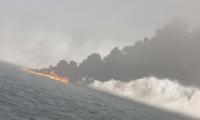The Rawal Dam is considered to be one of the major sources of drinking water for people residing in Islamabad and Rawalpindi. But from its latest pictures, it is heart-wrenching to see that extremely hot weather and low rainfall has left the dam barren and dry.
According to media reports, the water level has gone below the dead level. Once a popular picnic spot for families, the boats that once took tourists on tours of the scenic Rawal Lake are now parked on dry land.
Similarly, the most important source of water supply to Karachi, the Hub Dam, is also drying up rapidly. According to the water board’s officials, the water level in the Hub Dam has dropped to nine inches, and because of reaching the dead level, only 10 days’ stock of water is left for the east and west districts of Karachi. Experts are concerned that if there are no rains in the coming days the water supply to the residents could be completely halted by the end of July. The Hub Dam also supplies water to Balochistan.
Water is among the basic necessities of life. From ancient times to the modern era, water availability is ensured before establishing any new town or city. We also have examples of international countries such as Somalia and Ethiopia where water shortage had created the worst kind of humanitarian crisis.
The UN has ranked Pakistan among the five most unfortunate countries that are presently facing a water crisis. According to the UN report, per capita water availability in Pakistan has declined from 5,260 cubic metres in 1951 to below 900 cubic metres in recent years. According to international standards, a country must have at least 120 days of water stocked. But, regrettably, Pakistan has only 30 days of water storage capacity to meet its average needs, whereas our neighbour, India, has 220 days of water storage capacity.
It is a bitter reality that Pakistan had to face many problems as a result of the unfair distribution of water at the time of Independence. Accepting the intermediary role of the World Bank, India and Pakistan signed the Indus Waters Treaty Agreement in 1960. According to the agreement, control over the water flowing in the three eastern rivers – the Beas, Ravi and Sutlej – was provided to India, while the control over the water flowing in the three western rivers – the Indus, Chenab and Jhelum – was given to Pakistan.
However, India has reportedly built around 3,200 dams whereas the count of total dams and reservoirs in Pakistan over the height of 15 metres is not more than 150. Ironically, Pakistan has always had to face severe criticism of political parties over the construction of new dams. The credit for laying the foundation of the first dam in Pakistan goes to Gen Ayub – the Mangla Dam. In a short period of six years, the dam’s construction was completed. Later, work on other small dams, including Tarbela and Chashma, was also started. The Tarbela Dam has the distinction of being the biggest earth-filled dam in the world.
The issue of the Kalabagh Dam has emerged during the tenure of almost every government. It is said that the paper work of this project was completed during Gen Ayub’s era, while the construction began during Zia’s era. While some segments of our society are in favour of the Kalabagh Dam, there are also its opponents. Although the largest province supports the Kalabagh Dam, the other three smaller provinces oppose its construction. The water issue is not limited to one area and in the future the entire nation will have to face a severe water crisis.
According to a media report, our other neighbour, China, has constructed more than 87,000 small and big dams to combat the water crisis. China has also proposed to Pakistan that rather than wasting time on a disputed dam, we should construct 40 eco-friendly gravity dams that can generate electricity 14 times more than the Kalabagh Dam. There is also national consensus over the Dasu, Diamer-Bhasha and Munda dams.
The negligence, non-seriousness and the zero interest of all the past governments in the construction of new dams or water reservoirs is the key factor for the crisis that we are facing today. If Pakistan continues to not pay attention to its water reservoirs, we may have to face more serious consequences in the near future. The Pakistani nation, civil society and media all must demand the next elected government to address the issue of water crisis on an emergency basis. We must not forget that our laziness can permanently make Pakistan a water-stressed country.
The writer is patron-in-chief of the Pakistan Hindu Council.
Twitter: @RVankwani
An AI-powered robot waves at the onlookers at a tech show. — AFP/FileNine years ago, between March 9 and 15, 2016,...
Their children are also more likely to survive childhood, be healthy and attend school
Report notes that country has 800,000 heroin users and most commonly abused drugs are cannabis, heroin
Europe has vowed to stand with humiliated president in solidarity
On January 29 this year, mid-air collision, first major US aviation accident since 2009, challenged this optimism
Until these ideological foundations are dismantled, cycle of extremism will continue







